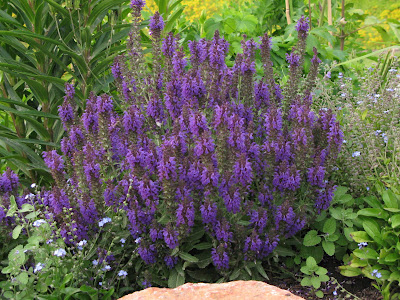Of course, remember that the foliage looks terrible after bloom time, so either plant them near the back, or rip them up when they're done (they come out very easily). These poppies are easily distinguished from the others by their blue-green foliage that is reminiscent of the color and texture of broccoli stems or cabbage.
Papaver somniferum, pale pink with pale purple cross :

The new color crosses have all come from crosses between this pale pink poppy and the dark purple poppies, from which I started two years ago. I assume that there is no cross-species pollination, so that the P. somniferum does not cross with the P. nudicale, P. orientale or P. miyabeanum in my yard. If any botanically-wise people know better, please let me know.
This year, I noticed one new color combination that takes my breath away. It's rather hard to capture in a photograph, though. It has deep pink petals with just a stain of grapey-purple on its edges.

Other combinations have included a new coral-red flower with a deep purple cross and a pale lavender flower with a deep purple cross. I've tied strings on the stems of these flowers so I can spread their seed for next year. The rest of the seeds will be excellent in muffin and loaves!
This year, for the first time, I grew some annual Shirley poppies (Papaver rhoeas) as well. I bought and sowed some "Cedric Morris Mix" from Thompson and Morgan and some poppy seed I surreptitiously collected in 2008 at a public garden in BC. I am guessing that these were P. rhoeas as well.
Papaver rhoeas, red and white flower:

This red and white flower had finely divided leaves, unlike the pink one, which had broader leaves. Has anyone else noticed a difference in leaves between the colors of this poppy, or maybe it's not even a P. rhoeas?
Foliage of the pink poppy:

Papaver rhoeas, pink flower:

While they are not poppies, I would just like to thank my Sweet Williams (Dianthus barbatus) for looking so fabulous in my raised beds. As an added bonus, they are fragrant! Once a patch is established, these biennials do a great job of putting on a long-lasting show of blooms with a nice mix colors.




































































